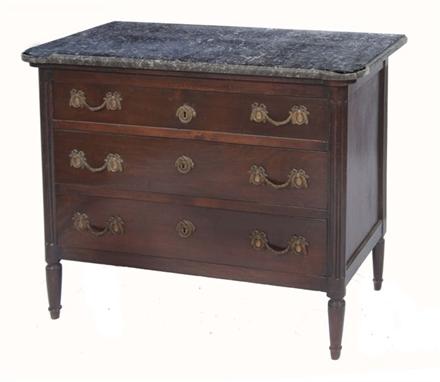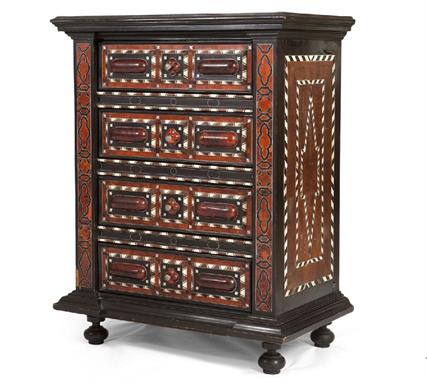We found 19970 price guide item(s) matching your search
There are 19970 lots that match your search criteria. Subscribe now to get instant access to the full price guide service.
Click here to subscribe- List
- Grid
-
19970 item(s)/page
A FRENCH GILT-METAL MOUNTED SATINWOOD, KINGWOOD AND ROSEWOOD BOMBE COMMODE OF LOUIS XV STYLE, EARLY 20TH CENTURY The Breche voilet marble top of serpentine outline, above a parquetry door enclosing a rosewood veneered interior with a single glass shelf 42¾ in. (108.5 cm.) high; 36¼ in. (92 cm.) wide; 17 in. (43 cm.) deep View on Christie's.com
A George III burr yew and sycamore crossbanded oval Pembroke table, circa 1780, with a single drawer on square tapering legs and castors, 72cm high, the top 89cm x 61cm overall. Provenance: Dumfries House, Dumfries & Galloway, Scotland. Following her marriage to Lord James Charles Crichton-Stuart in 1970 (son of the 5th Marquess of Bute and Lady Eileen Beatrice Forbes), Anna Rose and her husband received this Pembroke table as a gift from the furnishings of Dumfries House. The furniture collection is exceptional and is the most important collection of works from Thomas Chippendale’s Director period and the most comprehensive range of pieces produced by important Edinburgh furniture makers Alexander Peter, William Mathie and Francis Brodie. Whilst it has proven a challenge at this point to firmly attribute this table to a particular cabinet maker, the overall design and quality of the piece strongly suggests that it was made in the workshop of one of the finest cabinet makers of the period. The classic design of the table would entice possible attributions to the designs of Chippendale, Hepplewhite, Sheraton, the Linnell brothers, Mayhew & Ince, and possibly more, including some of the prominent Scottish makers that were commissioned to provide furnishings for Dumfries House. Whilst attribution of the making or design of this table is possible to a number of firms, research and evidence at this point has pointed positively towards an attribution to the firm of Mayhew & Ince. As discussed in Gilbert and Beard,The Dictionary of English Furniture Makers, 1986, the use of yew wood by Mayhew & Ince was the ‘only wholly idiosyncratic veneer wood the firm used and possibly unique’ to the firm among London cabinet-makers of this date, p. 593. Additionally, ‘moulded borders of commodes, tables and chests, especially when free of ormolu mounts, were often strengthened by ebonizing, a highly unusual device perhaps unique to the firm.’; op. cit. For a related piece of furniture in the Dumfries House collection, also attributed to Mayhew & Ince, See Christie’s catalogue, Dumfries House (Volume II) lot 195 for a George III serpentine commode (included in the 1795 & 1803 inventories). According to Christies footnote for the lot this commode belongs to a later phase of decoration at Dumfries, the commode was probably commissioned by Patrick, 6th Earl of Dumfries following his marriage in 1771 to Margaret Crauford, it bears many features in common with lady Palmerston’s French- fashioned bureau that was supplied in 1782 by the ‘Golden Square firm’ of Messrs John Mayhew & William Ince, it was inventoried in 1797 in her own apartments at Broadlands, Hampshire by Lady Palmerston as a ‘secretary made by Ince (17)82. (H.Roberts, ‘Towards an English Louis Seize. Furniture at Broadlands, Hampshire-11’, Country Life, 5th February 1981, p.346, fig.1’. For a related Pembroke table firmly attributed to Mayhew & Ince see Lot 110, Sotheby’s New York, 15th April 2010. A very similar harewood and yewwood marquetry Pembroke table attributed to Mayhew & Ince with entwined pearl strings, yewwood oval panels was sold, Christie’s, London, April 23, 2009, lot 186 (£12,500); an identical pair to this was sold, Christie’s, New York, April 25, 2008, lot 68 ($51,000).
A George III mahogany, satinwood crossbanded and marquetry serpentine chest of drawers, circa 1780, the frieze with a band of marquetry, above four graduated drawers flanked by outswept corners with marquetry banding, on bracket feet with scroll decoration, 79.5cm high, 87cm wide, 52.5cm deep. For a related commode see Christie’s catalogue, Dumfries House (Volume II) lot 195 for a George III serpentine commode attributed to Mayhew & Ince (included in the 1795 & 1803 inventories) see also footnote to lot 502 in this auction.
Two similar George III mahogany tray top bedside cupboards, circa 1780, each with a tambour fronted cupboard, above a commode drawer, 80cm high, 52cm wide, 43cm deep and 75.5cm high, 56cm wide, 41cm deep condition report:** Marks, scratches and abrasions consistent with age and use. Fading and abrasions particularly to the tops. Some old closed splits and minor chips. Handle to one tambour cupboard lacking. One commode drawer converted to a drawer
A Louis XV provincial carved walnut serpentine fronted bombe commode the top with a moulded edge the front with cartouche-shaped moulded panels, containing two short and two long drawers with brass foliate scroll handle pulls and cartouche foliate key plates, the shaped scroll apron base centred by a scallop shell and with moulded panel sides, on scroll feet, 130cm. (4ft 3in) wide.
A 19th Century French Empire mahogany commode of small size, surmounted by a rectangular panel of grey variegated marble, fitted with an overhanging frieze drawer and with three long drawers below, flanked by turned and brass mounted columns continuing to turned feet, 85.5cm (2ft 9 3/4in) wide.
A VERY GOOD FRENCH LOUIS XVI KINGWOOD AND MARBLE TOPPED COMMODE the white marble top supported upon a base of two short and two long drawers, all crossbanded and quartered, with ormolu handles and escutcheons, with scrolled ormolu sides, supported on short heavy feet. Stamped with EbŽniste mark `MP` and number `42`. 4ft 8ins wide, 3ft high, 1ft 9ins deep.
An early 20th century mahogany dressing chest (as viewed, flanking mirror plates missing), and a late 19th century commode fashioned as a small chest of drawers with hinged carpet lined top and small brown ceramic castors (57cms wide, as viewed, interior incomplete) and a mid 20th century walnut veneered sideboard in Art Deco style.
A George III mahogany serpentine commode, inlaid stringing, the moulded edge crossbanded top above four long graduated drawers, the top drawer originally fitted, on swept bracket feet, the back inscribed in chalk `Fonthill`, 33.25in (84.4cm) h, 38in (96.5cm) w, 21.25in (54cm) d. Provenance: from the estate of Niel Rimington (1928-2009) of Fonthill Old Abbey, Wiltshire.
A Regency rosewood breakfront bookcase, attributed to Gillows, inlaid stringing and satinwood banding, the detachable cavetto cornice (now fixed) above a pair of glazed doors flanked by further doors enclosing adjustable shelves, the base fitted with three oak lined frieze drawers above cupboards enclosing shelves, flanked by turned and tapering column supports, with wooden castors, 89.75in (228.3cm) h, 62in (157.7cm) w, 20in (50.5cm) d. The attribution to Gillows is based on stylistic similarities to a rosewood commode supplied by Gillows to Luke Dillon 2nd Lord Clonbrock, Clonbrock, County Galway. See Collard, Frances Regency Furniture, page 83 for a photograph of the aforementioned commode.
-
19970 item(s)/page

















































